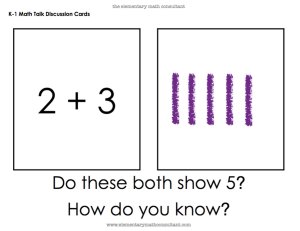More Talking in Math Class, Please
Talking about math helps elementary students deepen their understanding. Use these three tips to get the conversation started.
Your content has been saved!
Go to My Saved Content.Walk into a classroom in the middle of a math talk and you’ll see the students gathered in a circle, taking turns showing each other math strategies and questioning each other about the accuracy and efficiency of their solutions. The students are sharing thoughts about a single high-quality math problem they worked on solving earlier in the period without teacher guidance. They are processing the math in a different way than when they worked with paper and pencils, manipulatives, and drawings.
This opportunity to connect math and language benefits all the students and deepens their understanding of math concepts. The teacher listens as students converse about their problem-solving process. This gives her a view into the depth of understanding her students have, and alerts her to any misconceptions that should be addressed in later lessons.
After the students exchange ideas, the teacher will ask them to summarize important takeaways about today’s math concepts and strategies. Only then will she chime in with points she wants to emphasize. Here are three tips for guiding math talks.
1. Spend Time Discussing Just One Math Problem
Instead of modeling and assigning several practice examples to introduce a new kind of problem, give students a generous amount of time to solve just one challenging problem with as many strategies as they can. Requiring at least two strategies builds independence in verifying their own solutions and jump-starts students’ ideas for discussion. Once students have had ample time to work on the problem, bring the class together for a conversation.
2. Use the Power of Think, Pair, Share
Before students share with the whole group, teachers first give them a moment to think on their own and then talk to a partner. Their understanding develops at each stage of Think, Pair, Share. This is also a time when the teacher can gather important information from students, by circulating and hearing the thinking behind their problem-solving strategies.
Think: Students take a quiet moment to ready themselves to describe their process in words. Think time allows students who wouldn’t otherwise participate aloud (shy students, introverts, slower processors, and English language learners) to gather their thoughts and build courage to express them.
Pair: The teacher asks students to turn to a partner and take turns exchanging math strategies and observations. Pair time holds all students accountable for participating, and it allows students a practice run for sharing with the whole group. During this time, students connect math and language. Light bulbs go off as kids verbalize their mathematical thinking. Students who hesitate to share out to the whole group are given a chance to process and participate.
Share: The teacher asks students to share ideas with the whole group. Many teachers are surprised at how drastically participation increases when students have first had a chance to think to themselves and then practice sharing with a partner. Student shares are more eloquent, and the listeners are alert, making comparisons to how they and their partner solved the problem.
3. Take Advantage of Discussion Aids
Anyone who has taught math knows that it isn’t always easy to put math strategies into words. Kids need practice with the essential skill of communicating mathematical thinking, and there are several ways teachers can support them.
Math tools: Pattern blocks, grid paper, and base 10 blocks are examples of math tools that provide entry points for solving challenging math problems. These hands-on tools also give students something to describe as they show how they solved a problem step by step.

Visuals: Teachers can spark a math discussion with a teacher-made visual, like the math talk discussion card for kindergarten and first grade above. Or they can encourage students to show and explain a visual (a drawing or table, for example) that helped them solve a math problem.
Language support: During a math discussion, the teacher tries to talk as little as possible, setting an expectation that everyone is to be ready with a question or comment for the sharer. Sentence stems and vocabulary lists support students who struggle to put their thoughts into words and those who are learning English. Using “accountable talk” sentence starters like these turns one-at-a-time sharing into a class conversation:
I see that you used Math Practice _____ when you _____.
I think it would be more efficient to _____.
I will use your strategy next time because _____.
The part of your strategy I do/don’t understand is _____.
When I was stuck I _____.
The most challenging part for me was _____.
Teachers are often surprised at how well their students can question and support each other in describing a problem-solving process with some help from these language aids.
Providing lots of time for talking about and showing math strategies for just one problem may sound scary given teachers’ limited teaching time, but the payoff from a math talk is great. Students are exposed to multiple ways to approach the same problem. They hear various explanations of math concepts. As they listen, watch, and talk to each other, students begin to see patterns and make connections.
